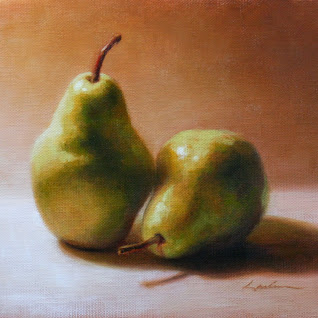I created studies of my son in preparation for this figurative landscape painting. I also painted Spring Light to work out colors for the landscape. My intention is to use the tree to portray the incredible intellectual, spiritual and physical growth of a young child.
11.30.2013
11.25.2013
Pear Study
by Lisa Larrabee
This painting was done as a relatively quick study as a teaching demonstration. The focus was on shape and shadow relationships.
This painting was done as a relatively quick study as a teaching demonstration. The focus was on shape and shadow relationships.
You can see that this study began with a horizontal composition. My painting surface is a sheet of paper canvas which is convenient for quick studies. The surface was toned with a mix of Gamblin's Transparent Earth Red and and Phthalo Blue thinned with Gamsol (OMS). The purpose of the blue was to neutralize the orange tones in the Earth Red. I chose Phthalo simply because it is transparent as well.
11.09.2013
Painting a Child Portrait
by Lisa Larrabee
It is a unique experience to paint the portrait of a child verses an adult. The proportions are a bit different, and the edges all seem softer. Even with this in mind, I had to take careful measurements and correct the placement of features and key shapes. I started this painting demo with a thinned wash of Gamblin transparent earth red and torrit grey. I have previously started this process without neutralizing the wash with grey. I found that it was more difficult to block in with accurate color over such a warm base, so I added the grey. Blue would have worked just as well to neutralize the orange tones. The image below shows how far I got in part one of my painting demo.
Subscribe to:
Posts (Atom)




